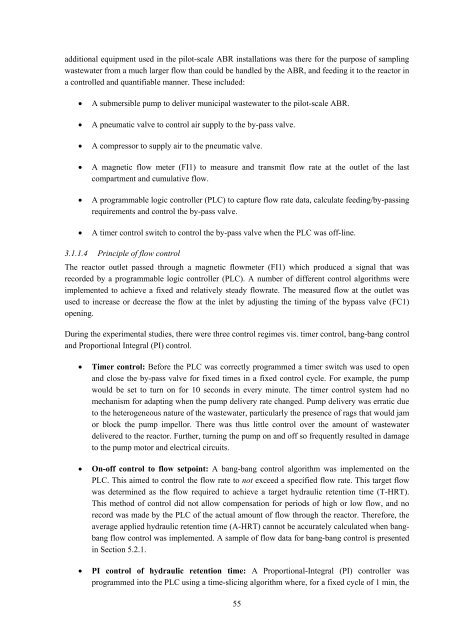analysis of a pilot-scale anaerobic baffled reactor treating domestic ...
analysis of a pilot-scale anaerobic baffled reactor treating domestic ...
analysis of a pilot-scale anaerobic baffled reactor treating domestic ...
You also want an ePaper? Increase the reach of your titles
YUMPU automatically turns print PDFs into web optimized ePapers that Google loves.
additional equipment used in the <strong>pilot</strong>-<strong>scale</strong> ABR installations was there for the purpose <strong>of</strong> sampling<br />
wastewater from a much larger flow than could be handled by the ABR, and feeding it to the <strong>reactor</strong> in<br />
a controlled and quantifiable manner. These included:<br />
• A submersible pump to deliver municipal wastewater to the <strong>pilot</strong>-<strong>scale</strong> ABR.<br />
• A pneumatic valve to control air supply to the by-pass valve.<br />
• A compressor to supply air to the pneumatic valve.<br />
• A magnetic flow meter (FI1) to measure and transmit flow rate at the outlet <strong>of</strong> the last<br />
compartment and cumulative flow.<br />
• A programmable logic controller (PLC) to capture flow rate data, calculate feeding/by-passing<br />
requirements and control the by-pass valve.<br />
• A timer control switch to control the by-pass valve when the PLC was <strong>of</strong>f-line.<br />
3.1.1.4 Principle <strong>of</strong> flow control<br />
The <strong>reactor</strong> outlet passed through a magnetic flowmeter (FI1) which produced a signal that was<br />
recorded by a programmable logic controller (PLC). A number <strong>of</strong> different control algorithms were<br />
implemented to achieve a fixed and relatively steady flowrate. The measured flow at the outlet was<br />
used to increase or decrease the flow at the inlet by adjusting the timing <strong>of</strong> the bypass valve (FC1)<br />
opening.<br />
During the experimental studies, there were three control regimes vis. timer control, bang-bang control<br />
and Proportional Integral (PI) control.<br />
• Timer control: Before the PLC was correctly programmed a timer switch was used to open<br />
and close the by-pass valve for fixed times in a fixed control cycle. For example, the pump<br />
would be set to turn on for 10 seconds in every minute. The timer control system had no<br />
mechanism for adapting when the pump delivery rate changed. Pump delivery was erratic due<br />
to the heterogeneous nature <strong>of</strong> the wastewater, particularly the presence <strong>of</strong> rags that would jam<br />
or block the pump impellor. There was thus little control over the amount <strong>of</strong> wastewater<br />
delivered to the <strong>reactor</strong>. Further, turning the pump on and <strong>of</strong>f so frequently resulted in damage<br />
to the pump motor and electrical circuits.<br />
• On-<strong>of</strong>f control to flow setpoint: A bang-bang control algorithm was implemented on the<br />
PLC. This aimed to control the flow rate to not exceed a specified flow rate. This target flow<br />
was determined as the flow required to achieve a target hydraulic retention time (T-HRT).<br />
This method <strong>of</strong> control did not allow compensation for periods <strong>of</strong> high or low flow, and no<br />
record was made by the PLC <strong>of</strong> the actual amount <strong>of</strong> flow through the <strong>reactor</strong>. Therefore, the<br />
average applied hydraulic retention time (A-HRT) cannot be accurately calculated when bangbang<br />
flow control was implemented. A sample <strong>of</strong> flow data for bang-bang control is presented<br />
in Section 5.2.1.<br />
• PI control <strong>of</strong> hydraulic retention time: A Proportional-Integral (PI) controller was<br />
programmed into the PLC using a time-slicing algorithm where, for a fixed cycle <strong>of</strong> 1 min, the<br />
55
















